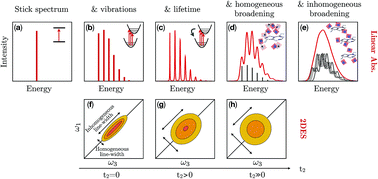当前位置:
X-MOL 学术
›
Faraday Discuss.
›
论文详情
Our official English website, www.x-mol.net, welcomes your feedback! (Note: you will need to create a separate account there.)
Modeling multidimensional spectral lineshapes from first principles: application to water-solvated adenine.
Faraday Discussions ( IF 3.4 ) Pub Date : 2019-12-16 , DOI: 10.1039/c9fd00072k Javier Segarra-Martí 1 , Francesco Segatta , Tristan A Mackenzie , Artur Nenov , Ivan Rivalta , Michael J Bearpark , Marco Garavelli
Faraday Discussions ( IF 3.4 ) Pub Date : 2019-12-16 , DOI: 10.1039/c9fd00072k Javier Segarra-Martí 1 , Francesco Segatta , Tristan A Mackenzie , Artur Nenov , Ivan Rivalta , Michael J Bearpark , Marco Garavelli
Affiliation

|
In this discussion we present a methodology to describe spectral lineshape from first principles, providing insight into the solvent-solute molecular interactions in terms of static and dynamic disorder and how these shape the signals recorded experimentally in linear and nonlinear optical spectroscopies, including two-dimensional electronic spectroscopy (2DES). Two different strategies for simulating the lineshape are compared: both rely on the same evaluation of the coupling between the electronic states and the intra-molecular vibrations, while they differ in describing the influence exerted by the diverse water configurations attained along a molecular dynamics (MD) simulation. The first method accounts for such water arrangements as first order perturbations on the adenine energies computed for a single reference (gas phase) quantum calculation. The second method requires computation of the manifold of excited states explicitly at each simulation snapshot, employing a hybrid quantum mechanics/molecular mechanics (QM/MM) scheme. Both approaches are applied to a large number of states of the adenine singlet excited manifold (chosen because of its biological role), and compared with available experimental data. They give comparable results but the first approach is two orders of magnitude faster. We show how the various contributions (static/dynamic disorder, intra-/inter-molecular interactions) sum up to build the total broadening observed in experiments.
中文翻译:

从第一原理建模多维光谱线形:应用于水溶腺嘌呤。
在此讨论中,我们将介绍一种从第一原理描述光谱线形的方法,以静态和动态无序的方式深入了解溶剂-溶质分子之间的相互作用,以及它们如何塑造在线性和非线性光学光谱学(包括二维)中实验记录的信号电子光谱(2DES)。比较了两种用于模拟线形的不同策略:两者都依赖于对电子态与分子内振动之间耦合的相同评估,而它们在描述沿分子动力学获得的不同水构型所施加的影响方面却有所不同(MD ) 模拟。第一种方法考虑了这样的水安排,例如对单个参考(气相)量子计算所计算出的腺嘌呤能量的一阶扰动。第二种方法需要使用混合量子力学/分子力学(QM / MM)方案在每个模拟快照中显式计算激发态的流形。两种方法都适用于腺嘌呤单重态激发歧管的多种状态(由于其生物学作用而选择),并与可用的实验数据进行了比较。他们给出了可比的结果,但是第一种方法要快两个数量级。我们展示了各种贡献(静态/动态障碍,分子内/分子间相互作用)如何加起来以建立实验中观察到的总拓宽。第二种方法需要使用混合量子力学/分子力学(QM / MM)方案在每个模拟快照中显式计算激发态的流形。两种方法都适用于腺嘌呤单重态激发歧管的多种状态(由于其生物学作用而选择),并与可用的实验数据进行了比较。他们给出了可比的结果,但是第一种方法要快两个数量级。我们展示了各种贡献(静态/动态障碍,分子内/分子间相互作用)如何加起来以建立实验中观察到的总拓宽。第二种方法需要使用混合量子力学/分子力学(QM / MM)方案在每个模拟快照中显式计算激发态的流形。两种方法都适用于腺嘌呤单重态激发歧管的多种状态(由于其生物学作用而选择),并与可用的实验数据进行了比较。他们给出了可比的结果,但是第一种方法要快两个数量级。我们展示了各种贡献(静态/动态障碍,分子内/分子间相互作用)如何加起来以建立实验中观察到的总拓宽。两种方法都适用于腺嘌呤单重态激发歧管的多种状态(由于其生物学作用而选择),并与可用的实验数据进行了比较。他们给出了可比的结果,但是第一种方法要快两个数量级。我们展示了各种贡献(静态/动态障碍,分子内/分子间相互作用)如何加起来以建立实验中观察到的总拓宽。两种方法都适用于腺嘌呤单重态激发歧管的多种状态(由于其生物学作用而选择),并与可用的实验数据进行了比较。他们给出了可比的结果,但是第一种方法要快两个数量级。我们展示了各种贡献(静态/动态障碍,分子内/分子间相互作用)如何加起来以建立实验中观察到的总拓宽。
更新日期:2019-12-17
中文翻译:

从第一原理建模多维光谱线形:应用于水溶腺嘌呤。
在此讨论中,我们将介绍一种从第一原理描述光谱线形的方法,以静态和动态无序的方式深入了解溶剂-溶质分子之间的相互作用,以及它们如何塑造在线性和非线性光学光谱学(包括二维)中实验记录的信号电子光谱(2DES)。比较了两种用于模拟线形的不同策略:两者都依赖于对电子态与分子内振动之间耦合的相同评估,而它们在描述沿分子动力学获得的不同水构型所施加的影响方面却有所不同(MD ) 模拟。第一种方法考虑了这样的水安排,例如对单个参考(气相)量子计算所计算出的腺嘌呤能量的一阶扰动。第二种方法需要使用混合量子力学/分子力学(QM / MM)方案在每个模拟快照中显式计算激发态的流形。两种方法都适用于腺嘌呤单重态激发歧管的多种状态(由于其生物学作用而选择),并与可用的实验数据进行了比较。他们给出了可比的结果,但是第一种方法要快两个数量级。我们展示了各种贡献(静态/动态障碍,分子内/分子间相互作用)如何加起来以建立实验中观察到的总拓宽。第二种方法需要使用混合量子力学/分子力学(QM / MM)方案在每个模拟快照中显式计算激发态的流形。两种方法都适用于腺嘌呤单重态激发歧管的多种状态(由于其生物学作用而选择),并与可用的实验数据进行了比较。他们给出了可比的结果,但是第一种方法要快两个数量级。我们展示了各种贡献(静态/动态障碍,分子内/分子间相互作用)如何加起来以建立实验中观察到的总拓宽。第二种方法需要使用混合量子力学/分子力学(QM / MM)方案在每个模拟快照中显式计算激发态的流形。两种方法都适用于腺嘌呤单重态激发歧管的多种状态(由于其生物学作用而选择),并与可用的实验数据进行了比较。他们给出了可比的结果,但是第一种方法要快两个数量级。我们展示了各种贡献(静态/动态障碍,分子内/分子间相互作用)如何加起来以建立实验中观察到的总拓宽。两种方法都适用于腺嘌呤单重态激发歧管的多种状态(由于其生物学作用而选择),并与可用的实验数据进行了比较。他们给出了可比的结果,但是第一种方法要快两个数量级。我们展示了各种贡献(静态/动态障碍,分子内/分子间相互作用)如何加起来以建立实验中观察到的总拓宽。两种方法都适用于腺嘌呤单重态激发歧管的多种状态(由于其生物学作用而选择),并与可用的实验数据进行了比较。他们给出了可比的结果,但是第一种方法要快两个数量级。我们展示了各种贡献(静态/动态障碍,分子内/分子间相互作用)如何加起来以建立实验中观察到的总拓宽。


























 京公网安备 11010802027423号
京公网安备 11010802027423号